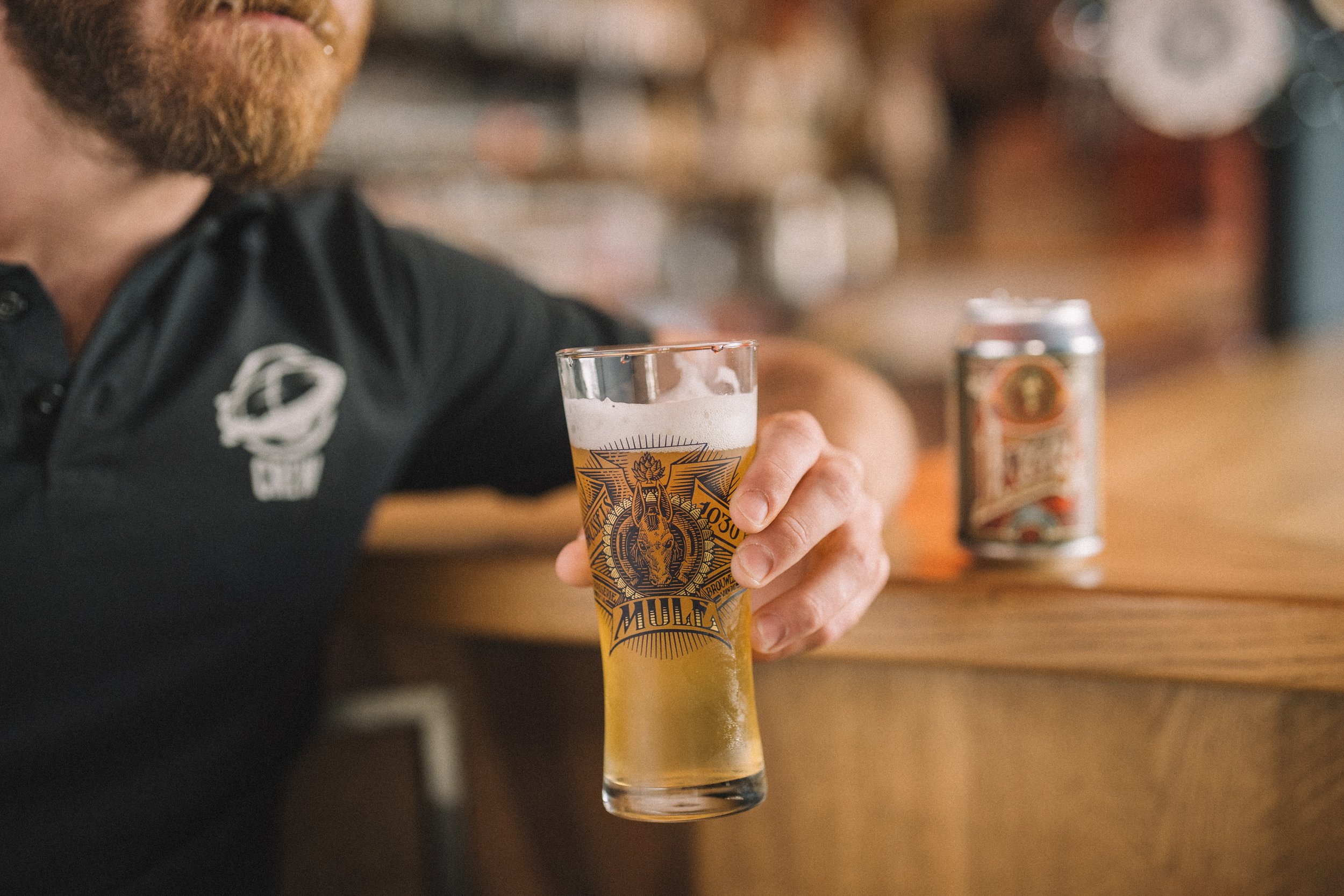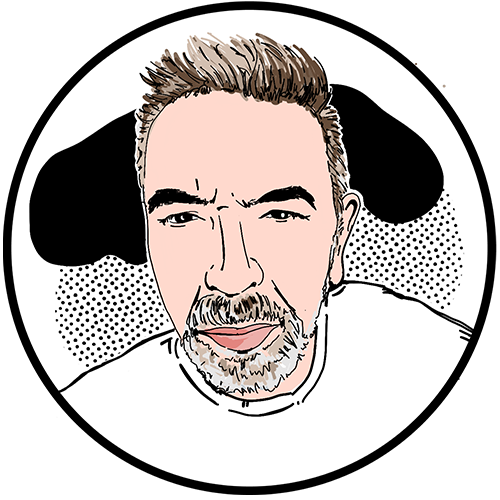In some ways, Brasserie de la Mule resembles other new breweries in Brussels. Its home is a 19th-century, brick-and-stone building in the Belgian capital’s lively, multicultural Schaerbeek area, once used as a stable for the horses that pulled the city’s first trams, hence the name. Its taproom is an elemental space of bare brick walls: air ducts running the length of the ceiling, wooden cable drums on their sides acting as tables, battered but comfortable-looking sofas in one corner, and a general air of decorative disarray. At first glance, it looks like a generic craft taproom, whose aesthetics can be seen elsewhere in the city at the likes of Brasserie La Jungle and CoHop.
However, the chalked-up beer list hanging behind the bar tells a different story from the one you would expect: The words helles, lager, and pils suggest that there is something unique going on. Alone in the Belgian beer scene, Brasserie de la Mule specializes in producing German-style beers, especially those from the family of lager.
Why should a focus on German styles like lager come as such a surprise, though? Jupiler and Stella Artois are massive sellers nationally. Many of the old-school, independent family brewers also produce a Pilsner-style beer, such as Haacht’s Primus or Dupont’s unfiltered Rédor Pils. Perversely, in the land where Lambic, gueuze, and Trappist ales are heralded and celebrated, lager is dominant. However, these beers might be popular, but they are often seen by connoisseurs as one-dimensional and simply designed to quench thirst as well as being easy on the pocket. Most of these beers have as much in common with the Ur-lagers of central Europe as a kangaroo has with a chicken—they both have two legs, but that’s it. This is why Brasserie de la Mule, led by its young founder and head brewer Joel Galy, is unique, especially as it has only been in existence for three years.
Apart from Brasserie de la Senne, which uses the method for Zenne Pils, Brasserie de la Mule is the sole Belgian brewery practicing decoction mashing. Its lagering times are also generous, with eight weeks at 0.5˚C (33˚F) being standard. All the beers are organic. For Galy, this approach is not an act of resistance to the monolithic nature of Belgian lager brewing. Neither is it one of blind faith, in that he saw a gap in the market and rushed pell-mell toward it. The story of the brewery is more of a deliberate and planned vision as well as one of a goal—or, perhaps, more precisely, an aim in bringing into this rumbustious part of Brussels a beer-drinking experience that has its roots in the cheery, communal pub culture of Bavaria.
“You get a little bit of the German taste not through getting the attenuation down, but because of what you get when you boil more of the tannin of the grain. That is for me the real German lager taste. It has to taste of the raw materials. ”
As we sit in the taproom next to the brewery, where the day’s brew is coming to its conclusion and the long sleep of fermentation and lagering awaits, a genuine enthusiasm surrounds Galy like a halo as he explains his founding principles.
“I use either single or double decoction for all my lagers,” he says. He uses the word “magic” to describe that process, adding that the technique also creates the correct flavor profile. “For me, you get a little bit of the German taste not through getting the attenuation down, but because of what you get when you boil more of the tannin of the grain. That is for me the real German lager taste. It has to taste of the raw materials.”
He has a very simple but effective approach to his style of brewing. Maybe it could even be called a philosophy.
“I don’t brew beer for beer’s sake,” he says. “I believe that beer has to be drunk in company, so beer has to be brewed for drinking.”
The main German styles are social beers, he adds.
“You don’t have to think about them when drinking them. You drink a beer and then you order another one. Your focus is not on drinking, but on being with someone, whether it be family, friends, or whoever.”
He takes a sip of his helles and expresses enthusiasm for German beer drinking, adding that he often crosses the border to experience it in person.
“You can sit down in a pub in Cologne or Dusseldorf and you have another beer coming straight away when you finish one. It is also good quality beer without too much special stuff inside.”
“I brew beer to be drunk in social moments, whether they are sad ones, happy ones, such as weddings, or hanging out with friends. ”
There is no sipping for me as I take a deep gulp from my glass of his wonderful helles. It is deep gold in color with a rich and rugged caramel note, though restrained in its sweetness. It is full-bodied. The low bitterness, long-lingering dryness, and bittersweet finish make it absurdly drinkable.
“The heart of our brewery is the bar,” he continues. “I brew beer to be drunk in social moments, whether they are sad ones, happy ones, such as weddings, or hanging out with friends. When you have a beer with too much flavor, you are not in the moment when you are with friends.”
He also mentions a more prosaic, and perhaps generous, reason for taking his particular path.
“I have so many good friends doing IPAs and I didn’t want to tread on their ground.”
As well as making excellent lagered beers, de la Mule’s other beers are a menagerie of rare beasts on the city’s brewing scene. These include a Berliner weisse, a dunkelweisse, and a hopfenweisse, which Galy says he initially fermented with yeast cultivated from a Schneider bottle. The hopfenweisse is ethereal and exemplary in the way the classic clove and banana notes of the weisse style link arms with a soft hop character. This is an extraordinarily drinkable beer despite being 8.2% ABV. Sadly, the Berliner Weiss wasn’t available on my visit, though it is a popular thirst-quencher in warm weather. There is also a saison, whose grist includes 45% roasted spelt.
Galy’s focus might be German beer, but his mind is not closed to other styles—though he says he won’t be making any NEIPAs any time soon, as he doesn’t like them. There have also been experiments with blending Lambics from Cantillon into the brewery’s hopfenweisse.
“We have a project involving cherry trees, which come from this area,” he says, talking about the famous Schaerbeek sour cherries that were traditionally used for kriek. “Cherry trees have been planted in the gardens of locals, and last year we mixed Cantillon and hopfenweisse and then added cherries locals had picked and they went home with the bottles. It was not sold commercially.”
“He is, still today, the only brewer to produce such beer styles, without real competition in Brussels or in Belgium.”
He also has plans to make his own Lambic when he can spare the time, which is not such a surprise: Galy spent a season working at Brasserie Cantillon, where owner Jean Van Roy remembers Gany being very attentive to the work of blending beers.
“It was certainly not a big deal for him to switch from the top fermentation brewery Brasserie de la Senne to a spontaneous one,” he says. “Moreover, de la Senne was producing some mixed fermentation beers, using Cantillon’s Lambic, and Joel was part of the project so I had no doubt about him acclimatizing to working with us when he came to spend a season.”
Van Roy says he felt very positive about Gany’s plans when they discussed the direction Gany wanted to take—so positive, in fact, that he bought shares in the brewery.
“At the time, I was quite sure that there was a place for good German-style beers in Brussels, even though it was not the opinion of the majority in the beer world,” he says. “He is, still today, the only brewer to produce such beer styles, without real competition in Brussels or in Belgium.”
When looking at the rest of the business, there is a real sense of a hands-on approach. Not only did Galy renovate and build the taproom’s interior and install the brewing equipment himself, he also oversaw the installation of a canning line. The cans are notable for their striking branding, which has been designed by a good friend, Ammo Amo, an artist also responsible for Cantillon and Brouwerij De Ranke labels.
“The initial idea for the branding was influenced by Art Nouveau,” Galy says, “I wanted a lot of color, joking that I wanted to make people’s eyes bleed.”
At the top of the label a logo features what looks like a feisty mule. There is plenty of color, deep and bold in its application, while the typeface shimmers with sinuous curves and a dynamic and expressive style. It is a forthright statement of branding that enables the cans to stand out amongst that multitude of beers that beg to be noticed on the shelves of Brussels’ beer shops.
Galy began his professional brewing career at the age of 21 at Brasserie de la Senne in 2013—though he had been homebrewing with his mother, Agneta Blom, since he was 16, learning the skills she’d picked up in her former home country of Sweden in the 1980s. As a death metal band sound-checked on the taproom stage, she explained how her son started to get interested in her brewing as a teenager.
“After secondary school he went traveling in South America and came back in 2013, and declared he wanted to become a brewer, though he had first said he wanted to be a sound engineer but then changed his mind. So in June of that year he started work at de la Senne.”
The job was part of a trial offering short-term employment to young people, but after his first week Galy was asked to stay for six months. The position then became full-time.
The founder of Brasserie de la Senne, Yvan de Baets, remembers how swiftly the young brewer developed during his time there.
“I could see his genuine passion for beer,” he says. “He always was the one I would naturally go to and have discussions about brewing and new ideas.”
“As a lover of German-style beers, I’m happy to have him in town. I also admire his courage, as these are not the style of beers conservative Belgian drinkers are used to.”
Galy worked at de la Senne until 2019, but left amicably after the brewery moved to its current home in the City of Brussels municipality, not too far from its original base.
De Baets describes Galy as “serious in what he does” and “uncompromising” in terms of beer quality.
“As a lover of German-style beers, I’m happy to have him in town,” he says. “I also admire his courage, as these are not the style of beers conservative Belgian drinkers are used to.”
Another sign of the two breweries’ friendship was a collaboration in the autumn of 2022, with the result being the 5.8% Zinne Lager, which celebrated 20 years of de la Senne’s iconic Zinnebir. According to de Baets, their goal was to make a reinterpretation of a classic. “Joel and I had the same idea: making it with the exact same recipe, but with a lager yeast and lager brewing methods such as tank conditioning and long lagering. The interesting thing is that we came up with the same idea without prior coordination.”
After de la Senne, Cantillon beckoned. When his season there was over, Galy had an offer to move to Mexico and work in a brewery. Any idea of crossing the Atlantic was junked when the pandemic began. Instead, he started to get organized, planning his new brewery over most of a year starting in May 2020.
“The first brew was in March 2021. Even during the pandemic we as a brewery could still sell beer, as it was classified as food. When I began planning the brewery in May, we didn’t realize the restrictions would go on so long, even though during the summer that year there was a hint of normality.”
As well as sourcing and putting together the brewing kit, the building needed a lot of work. The walls had to be cleaned, clutter cleared up, furniture brought in, and a bar built.
“We made everything ourselves, including the bar counter,” he says. “There was a lot of paint on the wall. We removed that, as we wanted to return to the bare brickwork, to get to the soul of the building.”
The atmosphere of the taproom is very much in tune with Galy’s aspirations for it to be a local hangout. He calls it a neighborhood bar; even though it sells his beers it also has other alcoholic beverages. There are several free concerts each week, with a focus on heavy metal, though other kinds of music such as rap are available. Its atmosphere makes him a contented man.
“I start brewing early in the morning, so I don’t always go to my bar,” he says. “But when I do and I see people smiling and enjoying themselves, I think of what a cool place it is and also recall it is my bar. That makes me happy.”
On a Thursday evening in mid-January, it has a mellow and yet chatty mood as a youngish crowd stand around laughing and talking or lounging on the cozy sofas. Elsewhere a group of four friends play table football with gleeful enthusiasm. On the compact stage to the right of the entrance to the bar, a four-piece rap band goes through their soundcheck before starting at 9 p.m. Their performance is edgy and intense, flattened by a heavy bass, into which a burst of melody springs with the agility of a cheetah on the hunt. The mix of this heady music with the helles hits the senses like a thunderbolt from on high.
“Thanks to Joel, people in Brussels got the chance to discover this whole new world of beer styles for themselves. He’s an easy-going, down-to-earth person, as are his beers.”
Earlier in the day, when the bar was closed and the staff were preparing for opening, I had asked Galy about de la Mule’s future. At the moment only its canned beers are sold outside the taproom, though if there is a collaboration, such as the one he did with fellow Brussels brewery La Jungle and, more recently, with brewing friends from Beermaster Brewery and Pub in Kyiv, the beers will go out into other bars and pubs. Last year, 1,100 hectoliters (937 barrels) were produced, though he expects to brew 1,500 hectoliters (1,278 BBLs) in 2024. Unlike some new breweries that want to reach for the moon and then set out for Mars, there isn’t a sense of expansion for expansion’s sake. Besides, the former stables are the brewery’s home, where Galy says he is happy to stay.
According to Brasserie La Jungle’s co-founder Christophe Bravin, de la Mule is important because it shines a spotlight on beer styles that were relatively unknown locally.
“Thanks to Joel, people in Brussels got the chance to discover this whole new world of beer styles for themselves,” he says. “He’s an easy-going, down-to-earth person, as are his beers.”
This is the real significance of de la Mule, demonstrating to the Belgian beer scene that lager can be a family of styles as beautiful and eloquent as the most divine Trappist ales or gueuzes.
Or, to put it another way, as Agneta Blom points out when she says that her son has achieved his goal, “You can come here to listen to music, and the beers are not too expensive. He was about to sign the contract for Mexico and then the pandemic came along and he couldn’t go.”
She pauses.
“I am rather glad about that.”
























